Ellen and Jim Have a Blog, Too
We are two part-time academics. Ellen teaches in the English department and Jim in the IT program at George Mason University.


Pallisers 3:5: Jane & George & Cora & Alice · 11 December 07
Dear Marianne,
As I’m almost finished with my study of Pallisers 3:6, I had better send you the third promised transcript of a scene from Pallisers 3:5: Simon Raven’s adaptation of Chapter 71 of CYFH? (“Showing How George Vavasour Received a Visit”); as those who have studied such film adaptations say, a comparison between Trollope’s scene and Raven’s shows the semi-originality and brilliance of such work.
Episode 25: “Leaving Town.”
Scene 29: A dark stairwell outside George’s lodging room. (We know it’s outside for Scene 28 has just shown us a dumb show of George writing out a fake identity [a little joke: he’s going on the SS Ulysses, a witty allusion suggestive of Raven’s admiration and sympathy for George], grabbing papers, burning them in a fireplace.)
1. Establishment shot: a woman seen climbing up a narrow dark stairwell.
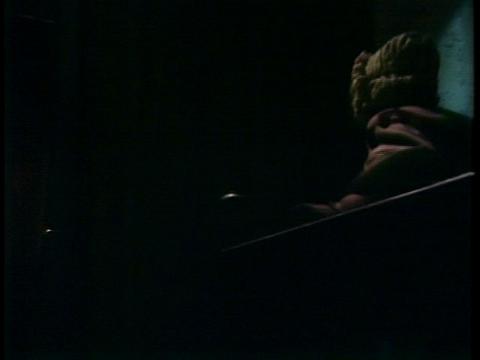
Jane (Wendy Williams)
2. The silent and wordless scene (in effect a continuation of Scene 28) shows a poorly dressed, cold, humble woman who is trying to look respectable as she fixes her hat, miserable gloves. She takes a posture that is humble before she knocks.
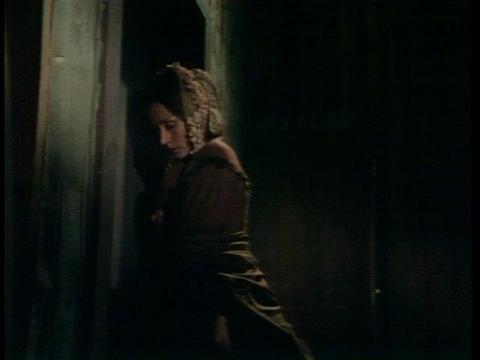
Scene 30: Back in George’s lodging room.
1. Establishment shot: we see Gary Watson sturggling with a
suitcase on the bed and suddenly alert as he hears the knock. He
then carries on.
2. Bridging shot: She opens door with a snap. He observes her, and she expects some sign, but he turns away as if she’s not there. She goes to close the door.
3. Wordless scene for a while: she looks up to him; he passes her and pays no attention.
4. Conversation pair (by and large Raven’s plays have been pairs of people):
George: Hummmn. He does make a noise.
Jane (smiles). Don’t let me stand here without speaking a word to me.
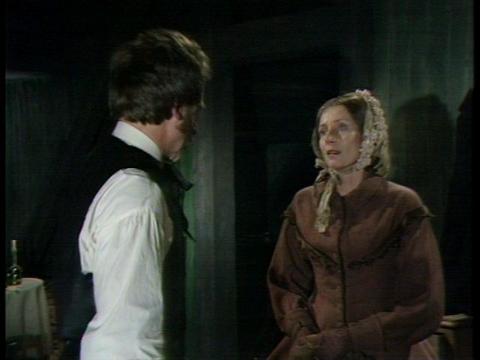
Jane and George Vavasour (Gary Watson)
George: I don’t want you to stand there.
Jane: George. What am I going to do? (goes over to him hanging onto his arm, desperate tone)?
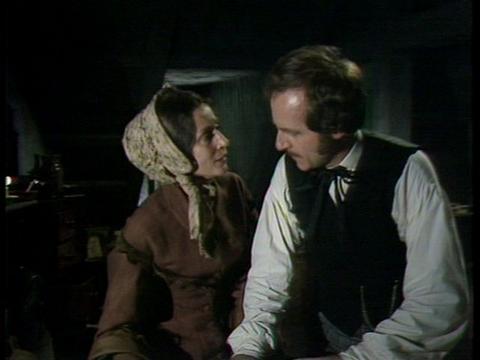
He looks at her, makes eye contact, moves quickly around her and goes to the fire.
Jane (turns): Where are you going, George?
George: Away.
Jane: For long?
George: Forever as far as you’re concerned.
Jane: What about your seat in Parliament?
George: Towfe (or some such ironic sound, laughing). That game’s over.
Jane: And the cousin you were going to marry? Is that game over too? (Close up of her face looking hard, sarcastic and pained all at once).
George: She didn’t play fair.
Jane: Hmmm. She found you out I suppose and now you’re runnign away in a tantrum.
George (laughs). Oh, if only that was all. You listen to me, Jane,
the news is out. I’ve been disinherited by my grandfathet’s will. As
soon as anyone knows where I am every Jew will be knocking at my door.
Jane: But you’re still a member of Parliament. You cannot be arrested for debt.
George: The vultures will over, Jane. As soon as Parliament is out, they’ll gobble me down to the bones so I’m getting out now before they get a proper scent of my carcas.
Jane: What about me? (She comes close to him and he does not move away)
George blows out the candle and moves into another smaller room. She follows him.
Jane: George, you wouldn’t wish me to starve.
George: On the contrary, nothing would give me more pleasure than to se that you’re well fed, plenty to eat, plenty to drink, and plenty of clothes to wear. Clothes are I believe what you care for most after all.
Jane: (Looks down at herself, relieved he seems to be paying
attention and remembering something.) Well, it was for your sake,
George. Because you liked it.
George: Yes I did like it (very bitter tone), but that as to come to
an ened with my others likings. You know very well I can do nothing more for you. What good do you do coming here to annoy me (spit out in hoarse tones).
Jane (firmer than before) I’ve come to you because I’m destitute.
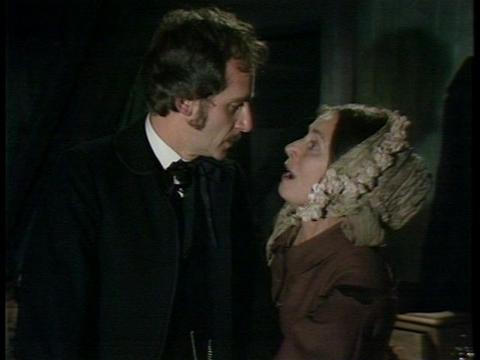
George: Well I’ve nothing for you. Not a penny.
Jane weeps with hands in shabby poor gloves. Moment of lost
control. Not faking it.
George: We’ve had this out before, Jane. I was to set you up with a that shop and you were to ask me for nothing more.
Jane: Oh that shop. I cannot even make enough to feed a canary.
George: I’ve got vultures to feed, jane. I’m a good deal worse off than you.
Jane: Oh, no, you’re not. You’re escaping. I can’t even do that.
Unless (she turns round to appeal to him and comes close again)
unless you take me with you. Please take me with you. I’ll go
anywhere you say. I’ll work for you like a slave.
George: No (growls), Jane. I don’t need company. (Implication: you do but I really don’t.)
Jane: Then what am I to do for money.
George: Sell the shop.
Jane: I’ve borrowed on it already. You know that. It’s worth next to nothing.
George: Then you’ll have to think, Jane, just as I’m thinking, what other assets you have. I have brains and strenght whch may serve me where I’m going. You … look at me Jane … [fierce look, he looks into her face and at her body and then pointedly smirks.] ... [she cries again] ... Oh yes you still have facets that can serve [he means prostitution, or finding some male any male].
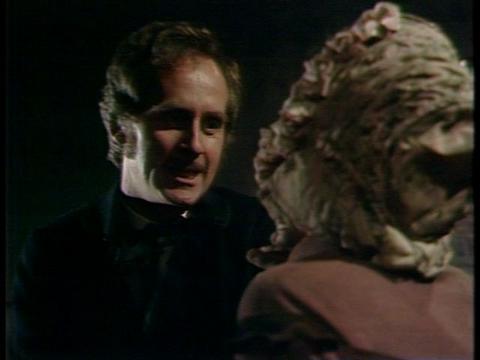
We see her from the back now; the camera now shows her slightly from the side; and we see her aging hat and strained face from the side. She knows he means to insult her too.
Jane: Oh! George. How could you?
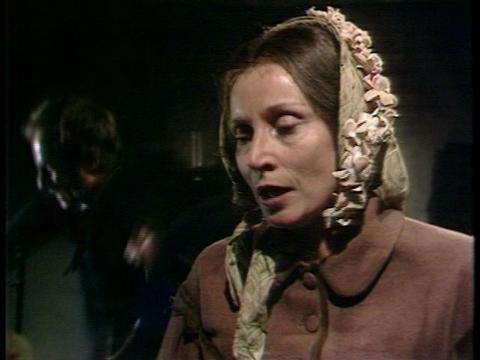
George puts his coat on.
George: Occam’s razor, Jane. You pare the problem down unti you come to the simplest possible answer, in this case the only possible answer.
Jane: There is another answer. [She is threatening suicide while
in Anthony Trollope’s novel it’s George who expresses a longing to
kill himself, even if half-bantering.]
George: Yes, but I shouldn’t give in, Jane. You never know you luck till the ball stops rolling. Goodbye, my dear. [putting on his
travelling hat.] If you want a keepsake, you’re welcome to anything you can still find here.
He moves away, takes the cases, and we hear his feet gradually
receding as he goes down the stairs.
5. A long still of her in the room. Camera dwells on her as she
stands there, allowing us to see the bottles on the table, and
crudity of everything around her.
A final slam from the bottom of the corridor.
*********
The parallels:
1) the scene immediately before 28 (Episode 24, “Truth Discovered”), there’s a rich gilded stairwell, beautifully lighted and Lady Glen (“Cora” he calls her) has just sent Burgo away forever, and sits there weeping hysterically again—in beautiful clothes with fancy cases downstairs. Her agon is real:
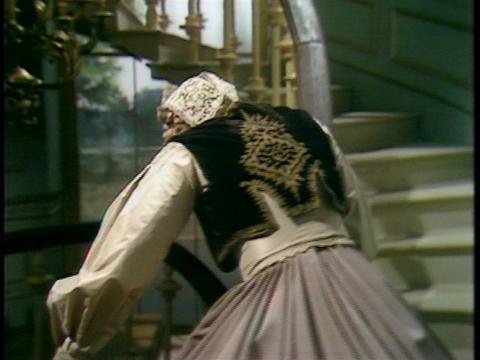
Lady Glencora (Susan Hampshire) dismissing Burgo
Nonetheless, her fate is not to become an individual all dismiss and would erase or take advantage of and then scorn. Jane’s fate is another variant of what might probably have been Lady Glencora’s fate had she gone with Burgo. Another is the the life of the beggar girl.
2) the scene between George and John Grey where George tries to strangle Grey and Grey throws him down the stairs and looks downward (also Episode 24, “Truth Discovered”).
3) the scene in 2:3: Burgo and the female beggar. Burgo also tells her he is worse off because he owes so much, and she looks at him as if he’s crazy because she is starving, freezing, has no wherewithal or options but the streets.
As with Burgo and the female beggar scene in Trollope, Raven has changed the tone and feel. Although Raven is much more sympathetic to George, Raven’s George is suddenly cold, hard and desperate and has no time for a leisured kind of talk (as also Burgo had leisured ways when he helped the female beggar in the tavern); Trollope’s George is more humane and it’s made clear that Jane did love this bastard. Raven’s George has the merit of acting more sincere, he seems realler than he ever did with Alice (where he postured and had flowery language).
The contrast with Trollope: it’s significant to note that for Trollope the tragic character in the novel is Alice Vavasour. The great disappointment or lacunae in the first six parts of Raven’s film adaptation is Alice is given no serious rationale for not wanting to marry Grey (self-destructive or no), and we learn nothing from her scenes with Grey or George that is not stereotyped (cant) thinking. Raven can pity women, but he cannot enter into their forms of self-destructiveness at length. In particular Raven admires the wild strong aggressive man, and has little understanding for psychological weakness, for depression, and for certain kinds of idealism that seem to him naive (say Mr Harding’s type).
Hence I’ve not transcribed any of Raven’s Alice’s scenes with George Vavasour or John Grey. They do not go the heart of any central issue in the films (or the novels): she struggles with George on the mountain top on a pragmatic ethical issue; she never explains to Grey why she does not want to marry him; we see she doesn’t want to end up like Lady Glencora, and Raven’s Alice is partly in love with George, but she is equally attracted to Grey (when he’s slightly violent particularly—a joke).
In Trollope’s novel, Alice is the central “she” we try to forgive. She’s the tragic heroine; in Raven’s films (1:1 – 3:6) Burgo Fitzgerald is. He is cast away as a woman in life whose wealth is taken and then erased (Lady Glen having an honorable loving husband avoids this more probable fate).
I wrote on Trollope-l:
“Trollope says for years he has had on his mind the story of a young woman who wrenched herself from a man because she could not give up her vile ambition. This is startling & revealing: it seems to me that Glendinning’s surmize of Trollope having love some girl who rejected him as beneath her (no money) is before us in the fiction. Alice is a variant of the woman who rejected him. He says he has finally forgiven her. We see such a paradigm in Dr Thorne where Dr Thorne’s engaged fiancee deserts him after the court case that shows his brother had impregnated Mary Scatcherd and gives Roger Scatcherd minimal punishment for having murdered Dr Thorne’s brother. Dr Thorne bursts into tears and vows never to marry, so desperate and isillusioned does he feel to be treated thus at such a moment.
Trollope has not treated this autobiographical material directly. He does invent a story where this woman who betrayed him is punished, suffers intensely and must be forgiven. But not in
details that correspond to anything he knew of her later life.
Instead he goes into the pathology of self-destruction. It’s believable and ironic Alice knows she does not love George upon seeing him agfain in the role of her bethrothed. I’ve had the experience myself and have met others who say they did that after 3 days of marriage, I knew what a bad choice I had made, but before I couldn’t see it. The veil is lifted. Luckily, I could divorce and eventually did. But that irony Trollope accepts. What fascinates him in this book is to see such a decision as unconsciously self-destructive and he goes at Alice’s inner life brilliantly. The opening of Chapter 37 is the equivalent of the chapter in Orley Farm where Lady Mason opens up her heart to Mrs Orme and shows her rage, anger, and seething relief that she got the property for her son and her desire to escape them all as well as remorse for having been caught (Rebecca).”
To this Nick replied:
“On this re-read I am much struck by how tragic a figure she is. All her control, her desire for and simultaneous distrust of, happiness
But I want to move beyond this because as the book proceeds
the portrait of Alice becomes more and more compelling, more
and more fascinating. It is of course true that the book really comes alive with Glencora (and to some extent the Widow) as Ellen noted, but I find James’ dismissal of Alice (which Ellen summarized) to be totally absurd. Trollope becomes absolutely fascinated with the character and her portrayal achieves a complexity and depth which I find rare among his female characters. Three aspects really strike me: the self-abnegation/self-punishment (which Leslie has noted), the linked distrust of happiness and the self-control. Perhaps one should add a fourth – her endless self-analysis ; but Trollope tells us that her self-analysis was very faulty (where her analysis of Glencora is good in Trollope’s eyes). Anyway, and here is where the wild speculation begins, the three features I have mentioned are classic symptoms of depressives. The psychological background of Alice’s childhood – the loss of her mother, an absent and emotionally distant father, Lady Macleod, a boarding-school from 12 to 19 (chapter 19) would all make a depressive personality and the three features mentioned highly probable. Her experience of happiness would have been limited indeed and she would have learned the necessity for self-control, for not revealing herself. When in young adult life she does open up her emotions, permits herself to be vulnerable for the first time – to George – she is deceived and betrayed which would reinforce her feeling that she is not ‘worthy’ of good things. This explains her rather strange relationship with both Kate and Glencora, far more open, openly emotional, expressive personalities. She is both attracted by them and yet feels her separateness and their difference.
Now it also seems to me that as well as attributing to Alice certain characteristics of a woman who rejected him, as Ellen has explained, Trollope has also put certain of his own characteristics into Alice. And, of course, in John Grey he gives us a man who also exercises great self-control (which is what causes Alice to misread him). But in a man Trollope suggests these characteristics are admirable. Grey’s ‘prudence’ is opposed to George’s ‘passion’ and the former is good, the latter bad. In a woman the position is somewhat reversed. It is not that passion is good but self-control and prudence are not good either (see Griselda). Alice’s self-punishment, her distrust and misunderstanding of happiness, her guilt (oh how she berates herself) can be read as much as symptoms of a depressive mindset as they can be as of Trollope’s moralising ‘punishment’ of a woman who has done wrong.
I replied as follows:
I want to bring in Trollope’s own life. I’ve argued here and elsewhere I think the most powerful passages in Trollope and characters are those who have strongly depressive qualities. The second part of Phineas shows us Phineas in deep depression (at the idea his friends could really believe he might kill for advancement; what does that mean about his relationship to them and also what the world accepts about people). In my book I suggest Trollope spent a long time as an older boy and young man (in London) depressed; his description of himself in London is of a typical paralsysis kind of state. What brought him out was Ireland: he escapes the crippling sense of inferiority and humiliation; he felt superior (alas, but it helped) and he loved the physical life. He began to write and in earnest. It helped enormously to be free of his mother and brother too.
I do think Raven recognized some of this for he has so much to pick from and he chose a pop restatement but also Grey’s words where Grey does suggest Alice is depressed (ill). This illness—a low view of the self—leads us to destroy ourselves and punish ourselves. Now Trollope doesn’t go as far in articulating this kind of thing, but he didn’t have the language. This is a pre-secular language for psychology era—only in novels was this sort of insight found and there also intermixed with stories and moral lessons for the wider public.
Leslie Robertson also wrote about Alice and her ugly green drawing room and the importance of Trollope’s Alice today:
“Alice’s ugly drawing room is ugly because neither she nor her father cared to make it not ugly. She left it to him, and he left it to a tradesman, who probably used to opportunity to get rid of the stock no one else wanted. Alice keeps it partly as a kind of self-mortification. Her father is extravagant and so she’s determined to pay for his sins by living in a space that is hideously ugly. This insistence on denying herself, on punishing herself, is part of the reason that she gives up John Grey (not the
only reason, of course). She imposes ugliness on herself, seeming to think that in some abstract way she is doing something highly
meritorious in the process.
“I see also a critique of an ideology of femininity that demands such self-punishing, that sees self-abnegation and self-
sacrifice as the noblest form of femininity. Certainly Trollope at
times buys into the same notion, that female willingness to sacrifice themselves and their needs to others is admirable and inherent to what it means to be a successful woman, but he’s also able to expose it as a destructive distortion. I think he’s doing that with Alice.
He does it to a certain extent in Orley Farm, too, by showing how Lady Mason’s willingness to sacrifice herself for her son has produced a moral monster, a man who sees kindness as weakness and who emotionally torments his mother for not sacrificing herself to him even more throughly than she already has. That notion of feminine goodness is a dead-end street, and I think that comes out with Alice. Acting in accordance with the notion that she must deny herself and punish herself, she does harm to others and herself. She’d have been better off having a healthy sense of self-preservation and self-respect. But I also see in Alice a hunger to do something noble, to do something great and good, and the only avenue she can see for that is masochistic and destructive; she reminds me very much of Dorothea Brooke in Middlemarch in that respect. So it seems to me he offers a powerful, if oblique, critique of a certain notion of femininity and the way it warps and damages them.”
I replied:
“Leslie’s comment has great general applicability. Go back to the 18th century in France and you find many male monsters (of egoism, arrogance, all supported by a hideous ideology of the ancien regime) and what has made them? Just this self-sacrifice destructiveness. This is one theme in the one truly Richardsonian novel by a woman of the era, one alas not published in full and unexpurgated and clear form until the 1920s: Louise D’Epinay’s Montbrillant. Montbrillant is the husband of the heroine, a cousin Emile is forced to marry when still young. And this paradigm is still operative today in the way motherhood is carried on and encouraged. The mother can emotionally torment and blackmail on the grounds of her sacrifice all the while she demands loss of what counts to the not truly ambitious child (let’s say).
This self-sacrifice was central to many a 19th century English heroine, and is not gone from many cultures when it comes to young women today either.
To conclude: Raven’s film adaptation has a very different set of concerns and different back or deeper and conventional story than Trollope’s (about male outcasts); while a resolutely masculinist and even misogynistic male, Trollope’s is the more penetratingly empathetic with women than Raven’s. There is in Raven, no comparable scene between Alice and either Grey or George, and those of Burgo and the beggar girl, Plantagenet and Lady Glencora Palliser, and George Vavasour and his ex-mistress, Jane. It’s simply that Alice rejects Grey because, well, he is not violent (!) enough, not exciting (though Trollope and Raven’s Alice does not value excitement), and the stills are correspondingly romantic stereotypes, pretty, appealing, but without anything gut-wrenching or content rich we can recognize:
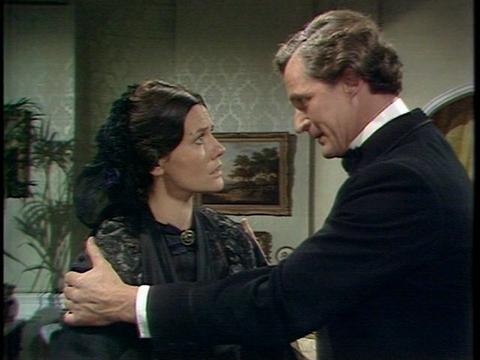
Alice Vavasour (Caroline Mortimer) putting off John Grey (Bernard Brown) in a nondescript green drawing-room
Trollope conveys Alice’s agonized self-questioning about what she should do with her life through subjective indirect narrative, not dramatic narrative, and in these long passages Raven is not interested.
Elinor
--
Posted by: Ellen
* * *
Comment
- For those who don’t know the passage by Trollope on Alice’s ugly green drawing room (Chapter 2 of Can You Forgive Her?), here it is:
I quote Chapter 2, the opening:
“I cannot say that the house in Queen Anne Street was a pleasant house. I am now speaking of the material house, made up of the walls and furniture, and not of any pleasantness or unpleasantness supplied by the inmates. It was a small house on the south side of the street, squeezed in between two large mansions which seemed to crush it, and by which its fair proportion of doorstep and area was in truth curtailed. The stairs were narrow; the dining-room was dark, and possessed none of those appearances of plenteous hospitality which a dining-room should have. But all this would have been as nothing if the drawing-room had been pretty as it is the bounden duty of all drawing-rooms to be. But Alice Vavasor’s drawing-room was not pretty. Her father had had the care of furnishing the house, and he had entrusted the duty to a tradesman who had chosen green paper, a green carpet, green curtains, and green damask chairs. There was a green damask sofa, and two green armchairs opposite to each other at the two sides of the fireplace. The room was altogether green, and was not enticing. In shape it was nearly square, the very small back room on the same floor not having been, as is usual, added to it. This had been fitted up as a “study” for Mr Vavasor, and was very rarely used for any purpose.
Most of us know when we enter a drawing-room whether it is a pretty room or no; but how few of us know how to make a drawing-room pretty! There has come up in London in these latter days a form of room so monstrously ugly that I will venture to say that no other people on earth but Londoners would put up with it. Londoners, as a rule, take their houses as they can get them, looking only to situation, size, and price. What Grecian, what Roman, what Turk, what Italian would endure, or would ever have endured, to use a room with a monstrous cantle in the form of a parallelogram cut sheerly out of one corner of it? This is the shape of room we have now adopted—or rather which the builders have adopted for us—in order to throw the whole first floor into one apartment which may be presumed to have noble dimensions—with such drawback from it as the necessities of the staircase may require. A sharp unadorned corner projects itself into these would-be noble dimensions, and as ugly a form of chamber is produced as any upon which the eye can look. I would say more on the subject if I dared to do so here, but I am bound now to confine myself to Miss Vavasor’s room. The monstrous deformity of which I have spoken was not known when that house in Queen Anne Street was built. There is to be found no such abomination of shape in the buildings of our ancestors—not even in the days of George the Second. But yet the drawing-room of which I speak was ugly, and Alice knew that it was so. She knew that it was ugly, and she would greatly have liked to banish the green sofa, to have re-papered the wall, and to have hung up curtains with a dash of pink through them. With the green carpet she would have been contented. But her father was an extravagant man; and from the day on which she had come of age she had determined that it was her special duty to avoid extravagance.
“It’s the ugliest room I ever saw in my life,” her father once said to her.
“It is not very pretty,” Alice replied … ”
E.M.
— Elinor Dec 12, 1:02pm # - A little more in the form of a complaint: In Trollope’s novel Alice’s ambitions are mocked and treated with derision as silly, but
while they are not mocked in the 20th century TV films, they are
not dramatized to show what was her point of view.
Further, in Raven’s films, Caroline Mortimer is most of the time dressed to make her look flat-chested or severe (like an “old maid”), and not pretty; she has a sour expression and on her face and (worst paradoxical betrayal of all) the woman who was (in Raven and Trollope’s shared words) forced “like a beast” to her “stud,” herself, Lady Glen, scolds Alice she ought to marry him and tells Gray to shake (a mild form of threatened beating) beat her. Then we get her accepting Grey after Raven provides evidence of his violence and she berates herself as unworthy of him some more.
Yuk.
E.M.
— Elinor Dec 12, 1:16pm # - “Dear Ellen,
Just a quick note to tell you how much I enjoy reading these!
I’ve added a link to your blog at my own, The Victorian Peeper (www.victorianpeeper.blogspot.com) ... I’d be very happy if you would consider adding me to your blogroll.
Best wishes,
Kristan Tetens
East Lansing, MI”
— Elinor Dec 12, 6:42pm # - From John H Blackburn:
“Hello (‘Shwmae’, in Welsh). Just a brief e-mail to say how much I’ve enjoyed looking at this splendid collection of images. As a VERY long term admirer of Jane Austen’s work I think I’ve seen every adaptation that’s been done. By far the ‘best’ (IMHO) is the Ciaran Hinds/Amanda Root Persuasion – not least because of the material.
It is one of the most poignant stories ever written and is a brilliant example of my favourite plot: what I used to call (in Eng. Lit. seminars, long ago!) the ‘Redemption Plot’. It is linked – in my mind – with the biographical evidence that J.A. had at least one very serious love affair; one which may have had a truly tragic ending. That second chance she gave Anne Elliott: she may well have ‘wished’ it for herself.
Thank-you too, for an image of the first woman I found attractive – the actress Barbara Murray!
‘Prynhawn da i chi’ – (Good afternoon to you).
Best regards. JHB”
— Elinor Dec 16, 7:59am # - Dear Mr Blackburn,
Thank you. I really appreciate commentary full-stop, and when it’s appreciation, praise and an intelligent point of view, I love it.
I think the 1995 Persuasion is a stunner and taken as a whole perhaps superior to the recent or 2007 Persuasion, but the 20007 Persuasion takes the point of view and depiction of Anne Elliot further into a brilliant portrayal of trauma and deep deprivation. It doesn’t have characters who are wrong (as Elizaberth Elliot is in the 1995) and avoids caricatures (Mrs Smith and Nurse Root in the 1995). Well no film is quite perfect; even the 1995 Sense and Sensibility has a few flaws as a film.
Ah. Barbara Murray. As I begin to write about the Phineas film and indeed for the rest of the Palliser cycle, I’ll remember your commment and keep putting up stills. I think the way Murray is depicted fits in the European stereotype of the femme fatale. Her first important role was Anna Karenina and in one remarkable Wednesday play on British TV she played the mistress of an ambitious man (played then by Donal McCann, who revealingly plays Phineas Finn here). I’ll write about all this too.
E.M.
— Elinor Dec 16, 8:00am # - From Nick:
Two passages are in my view linked. They are the scene in the gambling-house at Baden(ch 68) and that between George and his ex-mistress Jane (ch 71).
(The scene at Baden is of course the first of two such scenes
the second of which comes in the final week’s chapters and is strongly dramatic).I believe that the two scenes are linked in that Trollope is presenting what-if scenarios designed to assert
(or re-assert) traditional moral codes in respect of Glencora and Alice. What-if Glencora had run away with Burgo? What-if Alice has chosen George?
I am dimly aware that in the Baden scenes Trollope is using certain 19thC literary conventions – Ellen and others better read than me could supply the details. But – if we go back a few years could not one those women who hang around the tables, who ‘look like fiends’ to Alice have been Becky Sharp herself? She of course was a croupier where the women here are gamblers but the atmosphere is the same. Baden here is ‘other’ – not England; ordinary moral and social conventions are discarded. It comes near to a vision of hell, a circle of the Inferno, in Trollope’s description and he concentrates on the women.
Here is Alice in detail…
bq. ‘Look at the women who are playing. Is there one there whom it would not disgrace you to touch? Look what they are. Look at their cheeks, and their eyes, and their hands. Those men who rake about the money are bad enough, but the women look like fiends.’
then the narrator…
bq. ‘The women especially were staring at her,—those horrid women with vermilion cheeks, and loud bonnets half off their heads, and hard, shameless eyes, and white gloves, which, when taken off in the ardour of the game, disclosed dirty hands. They stared at her with that fixed stare which such women have, and Alice saw it all, and trembled.’
How strong is Trollope’s invective here. It is a horrible piece of writing; these women are unclean both literally (‘dirty hands’) and spiritually. They are contagious (it would be a ‘disgrace’ to touch them), they pollute, almost they are leprous. We are a long way from Burgo’s beggar-girl, or, as we shall see, George’s Jane. What is the difference? These women are unrepentant. They are indeed Becky Sharps. There can therefore be no pathos, no pity, no forgiveness. They are in the Inferno and there they shall remain. One can’t come up with any excuses for Trollope in all this – it is thoroughly unpleasant; xenophobic, misogynist, moralising.
But what is the point? Well of course that this is what Glencora would have become if she had eloped with Burgo. The coin which she throws on the table becomes a metaphor for her sexuality. She might have garnered delights initially (she wins and wins again) but then all would have been snatched away (she loses the lot) and she would have been left, the cynosure of all eyes, disgraced, fallen. Glencora herself is shown as intensely regretting her action the moment after she has done it. Trollope will not even allow her to have any pleasure from her gambling, no surge of adrenalin. She must be disconnected from the harpies who surround the table. Even her tiny lapse is portrayed as monstrous – Alice can hardly stand up such is her horror – and potentially calamitous. And of course it is Palliser who comes to the rescue, who leads Glencora away back to safety, to cleanliness. Marriage and propriety have been justified, and the awful consequences which would have ensued had Glencora followed her instincts have been shown in monstrous clarity.
As I remarked before the tale of George and Jane is very different. Ellen has written wonderfully about the way in which Trollope’s portrayal of Jane is suffused with pity and pathos. The scene is moving and sad; the horror is in George’s callousness, his final fall to the level of the beast. But nonetheless it also acts as a what-if. This is what would finally have awaited Alice if she had chosen wrongly : poverty, coldness, brutality, rejection.
There is much that is didactic about these two scenes. The novel as moral instruction – and moral instruction to women of course. They are both extremely powerful pieces of writing and that of Jane and George is vastly moving. But they leave a bad taste in the mouth for all that. Trollope is forcing the issue and the narrative by aligning bad practical consequences with bad moral choices – this is something he often conspicuously avoids (or at least until a last rather obviously forced concluding chapter).
I suppose he felt that he was already at the bounds of the possible in his examination of Glencora’s passion for Burgo.
Or perhaps he really wanted to retreat.
There is much more of interest – and of more pleasure! – in these chapters but I shall see how the time goes :).
Nick.
A few notes on the resolution of the sub-plot in the novel by Trollope.
In Chapter 65 we see the effective conclusion of the Widow Greenow/Bellfield/Cheeseacre story, with the Widow carefully managing everything to her own satisfaction.
What is interesting about this is the way in which Bellfield is portrayed at the end – he is in effect a sexual plaything, a gigolo, but he is also infantilised…
bq. ‘We could go to Yarmouth, you know, in the autumn.” Then the Captain’s visage became somewhat bright again. “And perhaps, if you are not extravagant, we could manage a month or so in London during the winter, just to see the plays and do a little shopping.” Then the Captain’s face became very bright. “That will be delightful,” said he.’
and a little later…
bq. ‘The Captain was to be allowedto come over from Penrith twice a week previous to his marriage; or perhaps, I might more fairly say, that he was commanded to do so. I wonder how he felt when Mrs Greenow gave him his first five-pound note, and told him that he must make it do for a ortnight?—whether it was all joy, or whether there was about his heart any touch of
manly regret?’
Now Trollope is very clear that he considers that this arrangement is satisfactory and will work….
bq. ‘Therefore, I say that Mrs Greenow had been lucky in her choice, and not altogether without prudence.’
and Bellfield is content…
bq. ‘Captain Bellfield, of Vavasor Hall, Westmoreland. It don’t sound badly,” he said to himself, as he travelled away on his first journey to Penrith.’
It is all a fascinating vision and in terms of the story parallels the comparison must be between Bellfield and Glencora (the other infantilised character) – quite clearly Bellfield at this stage has no relation to any of the other men in the book (George, John Grey, Palliser). It is a question of he or she who pays the piper calls the tune. Obviously the ‘she’ here is significant. Does Trollope allow this power relationship because it is a comic sub-plot? Or is it because Widow Greenow is a widow? It is really necessary for us to laugh at the story because if taken seriously it is quite unpleasant (as may swiftly be seen if we transpose it in terms of the sexes – which is of course the common situation in both Trollope and 19thC life). Trollope gets away with it by making the sub-plot comic, the Widow very likeable and Bellfield a fool.
Or is Trollope portraying a relationship with a drastic power imbalance before he returns to the serious business of
Glencora/Palliser and Alice/Grey?
Nick.”
— Elinor Dec 31, 11:17am # - Dear all,
Many thanks for Nick for these startlingly perceptive and candid postings. I heard nothing so rigorously true at the MLA: under the banner of “balance,” everyone covers their you-know-what’s lest they offend someone somewhere. Also there is the stance of supposed objectivity to control what’s said.
Pray pardon me now if I bring in another text and film from another area (eighteenth-century): we will (I really hope) be talking of the 18th century when we come to read Thackeray—whose Barry Lyndon by-the-bye I’ve never read (nor the novel with Colonel Newcombe—I’m not even sure which one that is). I’ve returned to a text which deeply engaged me for years as a graduate student (I did my dissertation on the influence of Richardson’s Clarissa and Grandison on women’s fiction and readers for a half century and thereafter), when I first came onto the Net (I led a reading and discussion of Clarissa online:
http://www.jimandellen.org/showclarydates.html
and now with these film studies I’m into the adaptation by David Nokes and Janet Barron. I know little of Barron but know Nokes as an excellent biographer (of John Gay and Jane Austen) and student of poetry (Alexander Pope—in the film adapation Nokes remembers Pope’s Windsor Forest where a beautiful bird is killed and has Lovelace shoot one down in “autumn” and wring its neck while he talks to Belford of Clarissa).
What purports the nomination of Clary and Clarissa. In the third part of the film, it takes off into greatness. Why? In the second half we travel to Mrs Sinclair’s brothel and meet the prostitutes to whose house Lovelace has taken Clary. In this part of Richardson’s novel but much more in the film adaptation imagery just such as Nick has aptly described and commented on in Trollope is used in masquerade Writ Large style to make the same message—and in both I have to admit the prostitutes are shown no sympathy but are figures of terror. Nightmare. (In Parts 1 & 2 unlike Richardson Nokes & Barron pull their punches, unwilling in part to show the potential pathologies and cruelties of family life as a sheer system and turn to sexualize the Harlowes and it doesn’t work as powerfully as the novel—and throughout the loss of epistolarity is utterly weakening.) Diana Quick (Julia) is particularly powerful as the opposite of Clary and what Clary might become: as Nick suggests the issues are wide, but one element in both is sincerity and performance. The good woman is not allowed to perform. When the false Lady Betty (quick) pulls off her wig, we see her real hair is filthy.
By contrast, Andrew Davies’s depiction of the croupier table and Becky Sharp may be said to be the climax of his film adaptation which has shown sympathetically as well as in a distanced manner how she got there.
This imagery is used by Trollope in Miss Mackenzie for a bazaar when women come out to sell things—they are horrifying harpies.
Turn to Nick’s comment on the infantilization of Bellfield: indeed the Widow Greenow story if taken seriously is very unpleasant. The first time round when we read the novel we had with us an openly gay man and he would talk of the cruel mockery of Cheeseacre (there’s some self-hatred in Trollope for these awkward unloved men are partially him too); we also talked of how the Widow is a caricature of Fanny Trollope (in part yes, linked through her book The Widow Barnaby).
It seems it’s okay for a woman to be bought—and thus infantilized, but also (unexpectedly) men. But note that Trollope leads us to despise Bellfield and to value Glencora because they allow themselves to be turned into powerless children. Also that neither Trollope nor Raven infantilize Burgo (a remittance man in Victorian terms. Both male writers sympathize deeply with the male outcast -- not the female one or only when she's pathetic like Jane and the beggar girl, helpless, a figure of genteel pathos going down to prostitution (Jane) or adoring and submissive (the nameless girl).
Raven drops the whole of the Greenow incident; however he does deal with powerful women and he dislikes them—in the Palliser films, we have Burgo’s aunt, the two aunts who force Glencora to marry and one whose behavior is show in the film almost to lead Alice to reject Grey (this is a wholly new enunciation of the story), and they are presented as harpies. I did show this in my blog. When we come to the Lizzie Eustace/Lord Fawn story matter in the Palliser films I expect that one of the elements that is so grating and ugly is Raven’s response to the Becky Sharp type in Lizzie Eustace. He can’t go as far as Trollope to show her in her fullness as to let her sexuality show is even more threatening. I have to say this contrast makes Davies’s consciously liberal attitude towards women (it’s not as liberal as he thinks) at least healthy or pleasant in comparison andmuch more feminist.
This is really very helpful to me in thinking about the films I’mstudying—and important issues in life and reading and pictorialism too.
Ellen
— Elinor Dec 31, 11:18am #
commenting closed for this article
